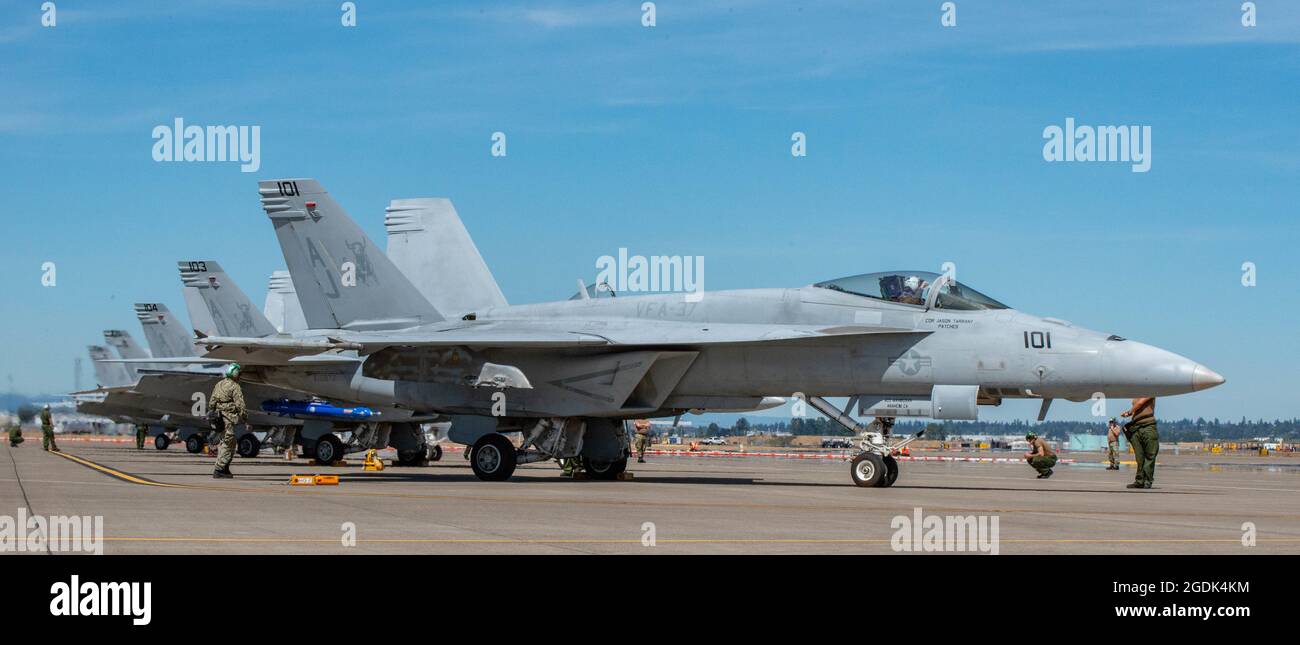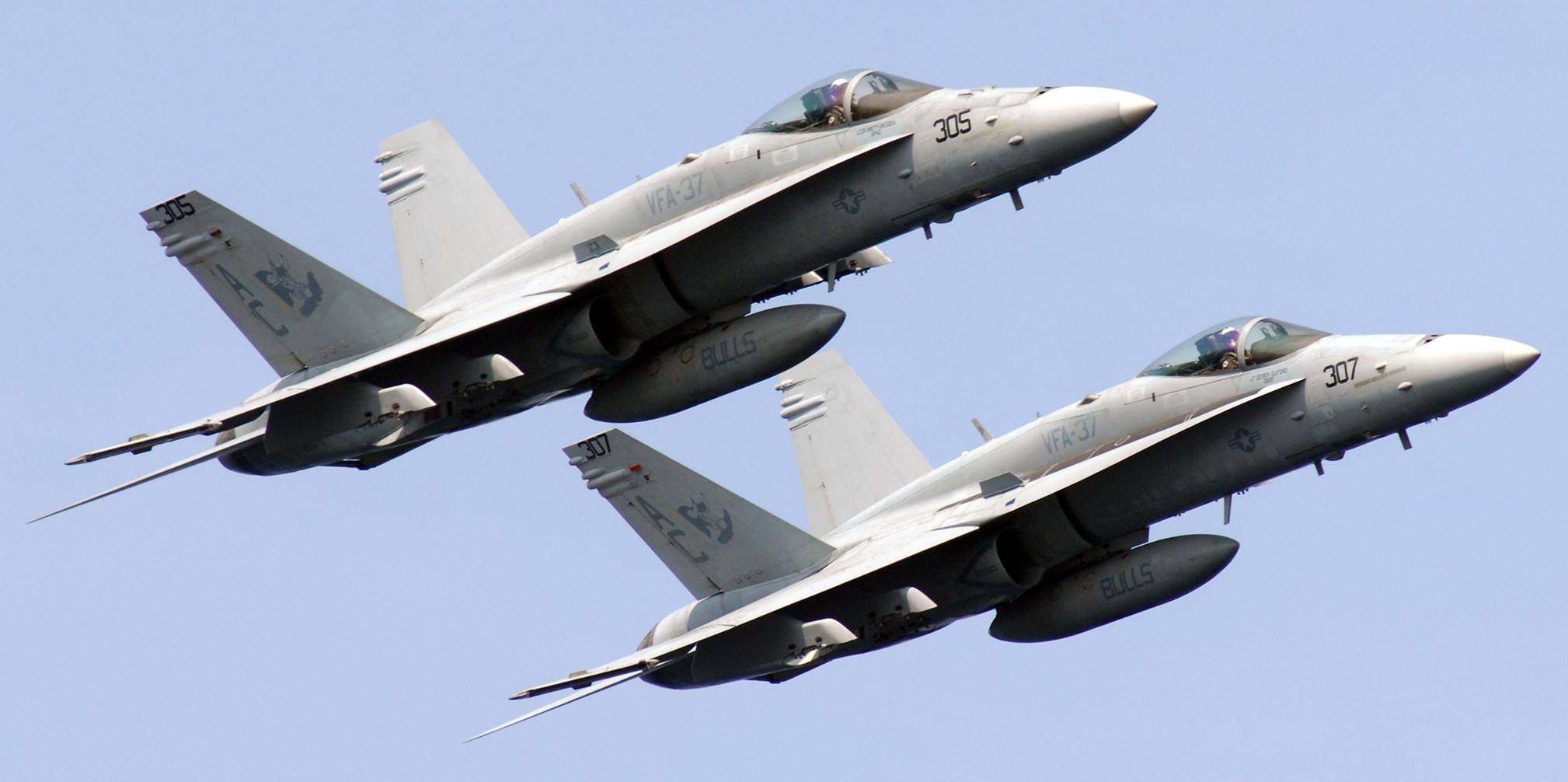Vfa-37 Super Hornet - Original | US Navy ships | US Navy - Air Units | USMC - Air Units | International Navy | Arms | Special reports
July 2013 - April 2014 CVW-3 with USS Harry S. Truman (CVN 75) January 2017 - ? Aboard USS George HW Bush (CVN 77) with CVW-8.
Vfa-37 Super Hornet

F/A-18C Hornets (300, 301 - VFA-37 / CVW-3) USS Harry S. Aboard Truman (CVN 75) - January 2014
File:fa 18c Hornet Of Vfa 37 Lands On Uss George H.w. Bush (cvn 77) In The Arabian Sea On 6 April 2017.jpg
F/A-18C Hornet (VFA-37/CVW-3) aboard USS Dwight D. Eisenhower (CVN 69) during carrier maneuvers - November 2008
F/A-18C Hornet (VFA-37/CVW-3) with EA-6B Prowler of VAQ-130 on USS Harry S. Truman (CVN 75) - March 2007
F/A-18C Hornet (VFA-37/CVW-3) over USS Harry S. Truman (CVN 75) in Iraq - November 2004
F/A-18C Hornet (VFA-37/CVW-3) with other F-18 USS John F. Kennedy (CV 67) - February 1993
Mildenhall Supports Navy During Exercise Saxon Warrior
Attack Squadron Three Seven was established in July 1966 as an A-7A group. Bells was commissioned in December 1967, first aboard USS Kitty Hawk (CV 63) in 1969. VFA-37 deployed 24 times to nine destinations. Different aircraft carriers in their 42-year history. Bells flew light attack missions in the Indian Ocean, twice in Vietnam, once in Iwakuni, Japan and once "around the world" aboard USS Carl Vinson (CVN 70).
The squadron's second tour of duty was in Vietnam in May 1972 aboard the USS Saroga (CV 60). Bells arrived at Yankee Station and flew approximately 2,800 missions and delivered more than 3,100 tons of ordnance to Yankee Station and began a nine-month joint operation.
In April 1973, the Bills received the first A-7E, an updated version of the A-7A. It includes improved navigation and weapon systems, state-of-the-art avionics and superior aircraft performance. Belize flew seven cruises with the A-7E in the late 1970s and early 1980s. During this time, VA-37 responded to several regional crises in the Mediterranean Sea and Indian Ocean.
In 1984, Bales was assigned to work with the US Navy in Iwakuni, Japan. During this deployment, the squadron was sent to Yecheon, Korea, becoming the first Marine squadron to deploy to field conditions since World War II.
Aircraft Photo Of 164240
After returning from Japan, Bells sailed three times aboard the USS Forrestal (CV 59) to the Mediterranean and Indian Ocean in the 1989–90 Mediterranean cruise, the last in the A-7E Corsair II. Accomplished with Cruise Bulls Safety "S", Atlantic Fleet Combat "E", and Golden Tail Hook Award (for achieving the highest overall landing rating of six by a carrier air wing).
In August 1990, Bales was detached from Carrier Air Wing Six and attached to Commander Light Attack Wing One. After the invasion of Kuwait, five Bulljets were transferred to VA-72 on short notice for Operation Desert Shield.
Over the next three months, the Bills provided aircraft-ready A-7E pilots, aircraft, and maintenance personnel to support light strike teams preparing for combat. On October 31, 1990, Tim Bell flew the last official flight in the A-7E Corsair II. The incident ended a 25-year association with the "Harley of the Fleet" that had accumulated 115,000 flight hours and more than 25,000 arrests.
On November 15, 1990, Strike Squadron Three Seven was officially redesignated Strike Fighter Squadron Three Seven, receiving its first FA-18 Hornet on December 13, 1990. On September 01, 1991, Group Bell was attached to Carrier Air Wing 3 (CVW-3) aboard the USS John F. Kennedy (CV 67).
F/a 18 Hornet
From October 1992 to April 1993, Bells deployed to the Mediterranean Sea as part of the John F. Kennedy Battle Group. During this deployment, the Marines participated in several exercises with our partners and were key participants in Operation Calm near northern Iraq and the former Yugoslavia.
Upon returning from a 1993 Mediterranean cruise, Bills began another round. Throughout the year, the team continued to refine its air-to-air and surface-to-surface tactics in preparation for a six-month deployment aboard the USS Dwight D Eisenhower (CVN 69) beginning 20 October 1994. In sea and Arabian Gulf voyages, Bales supported Mission South White over Iraq and later Operation Dani over Bosnia. Belize has participated in large-scale exercises with Kuwait, Saudis and Israelis and other NATO allies.
In November 1996, Bulls embarked with CVW-3 aboard the USS Theodore Roosevelt (CVN 71). Bales flew in support of Operation Southern Watch in Iraq and Operation Deliberate Protection over Bosnia-Herzegovina. VFA-37 participated in major exercises in the Mediterranean Sea and the Arabian Gulf.

VFA-37 redeployed to the Arabian Gulf in November 1998 with CVW-3 aboard USS Enterprise (CVN 65). After participating in Operation Southern Watch for four weeks, he was given executive command of Operation Desert Fox in Iraq. The Bells performed exceptionally well, flying 44 planes and delivering 46 tons of ammunition during the four-night combat operation. VFA-37's review was the best in the air wing and the operation was completed without any friendly casualties.
Hn 438, Military Finland, Mcdonnell Douglas F/a 18c Hornet, Cn 1449/fnc038
Group Bell and the Enterprise battle group left the Arabian Gulf in January. During the next five-month deployment, VFA-37 flew missions over the former Yugoslavia in Operation Deliberate Force and again over Iraq in Operation Southwatch.
The Regina Bulls moved from NAS Cecilfield, Florida to NAS Oceana, Virginia in July 1999. The Belize's next major deployment was the maiden voyage of the USS Harry S. Truman (CVN-75) in 2000.
In December 2002, VFA-37 embarked on its second cruise at Truman. On March 19, 2003, Tim Bill joined the Muslim Brotherhood in charge of Operation Iraqi Freedom (OIF). While flying from Truman in the Mediterranean, Bales took part in the "Suspicion and Fear" campaign in southern Iraq before focusing on supporting U.S. forces in northern Iraq.
At the end of a successful 30-day air campaign in OIF, Bells had flown more than 1,200 hours and 252 sorties over northern Iraq. The squadron's pilots delivered more than 144 tons of ordnance and fired 9,400 rounds of 20mm HEI ammunition. The squadron maintained a 100% combat grade completion rate and an excellent safety record. On Memorial Day 2003, the team returned to Virginia for the Homecoming of Heroes.
Afd48035 1:48 Afterburner Decals F 18c Hornet Vfa 37 Ragin' Bulls Oif 2006 2008 #48035
In October 2004, Team Bell and CVW-3 departed Norfolk and proceeded to the northern Arabian Gulf aboard Truman. On 21 November 2004, HST stood at the tip of the line and began combat operations in support of OIF. On March 18, 2005, the air force base was closed. By the end of the VFA-37 campaign, the squadron had flown approximately 430 hours in support of Iraqi Freedom and 2,100 sorties.
In 2007, the Ragin' Bulls celebrated their 40th anniversary. After completing 8 sustainment missions with the carrier air wing the year before, VFA-37 began working with CVW-3 for another deployment. The Truman Strike Group departed Virginia on November 5, 2007 in support of Operations Enduring Freedom and Iraqi Freedom. The group returned from the cruise in June 2008.
There was a waiting period for the goats after returning from the 7 month stay. VFA-37 Ragin' Bulls are currently attached to CVW 8.
F18 super hornet model, f18 super hornet toy, fa18 super hornet, super hornet 150cc parts, f 22 super hornet, super hornet model, super hornet, tamiya super hornet, vfa 37 ragin bulls, tamiya super hornet parts, vfa 37, 150cc super hornet
0 Comments